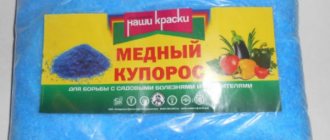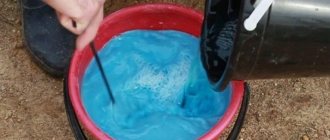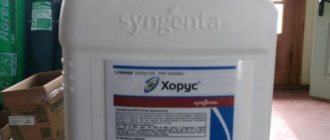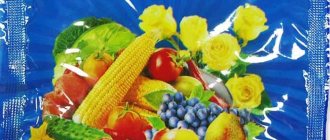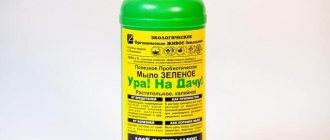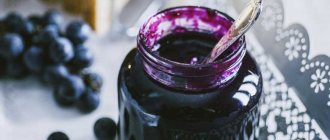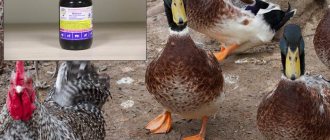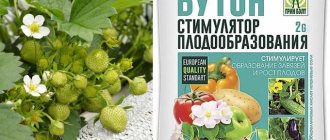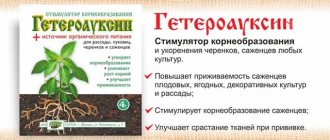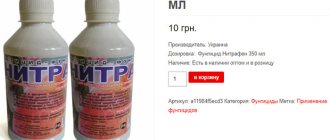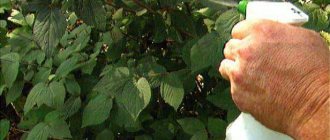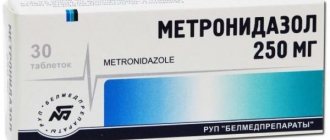Treating grapes with copper sulfate is part of the arsenal of mandatory activities for any amateur gardener. The drug is widely used in agriculture due to its fungicidal properties - the ability to eliminate pathogenic spores, fungi, and various plant diseases. Along the way, it fertilizes the soil, that is, it performs two tasks at once. It is simply irreplaceable for vineyards, because fungal infections for the vines are often disastrous.
There are many rumors about the use of copper sulfate for grapes; after all, the substance belongs to the class of poisonous and can harm the plant if not processed correctly. But most experienced gardeners on specialized forums advise beginners not to be afraid to use this drug and not to abandon it. In a precisely selected dosage, the substance will only bring benefits to the vine.
Copper sulfate
What beginner gardeners should know about copper sulfate
Copper sulfate is a fertilizer that comes in the form of bluish crystals. From a chemical point of view, this substance is a compound of copper salt and sulfuric acid, so it also has another name: copper sulfate. The composition is perfectly assimilated in water, which makes it possible to obtain a solution for spraying grapes.
It is permissible to use fertilizer as a top dressing, because copper sulfate is the same copper, only in a different form, in which the microelement can be absorbed by plants. It is necessary for grapes for strong immunity, resistance to drought and frost. With its deficiency, there is a delay in growth and fruiting, and wilting.
Copper sulfate can be unknowingly confused with iron sulfate, although these are two completely different substances. Ferric sulfate is emerald green crystals.
Iron sulfate
Copper sulfate is added to the soil as a top dressing in very small doses, the same applies to spraying to combat fungal and other diseases. If you handle the drug carelessly, it can burn the vine and cause harm to yourself. The peculiarity of this substance is that even in a well-diluted form it very effectively helps with various kinds of problems, for example, it gets rid of phylloxera - a real threat to vineyards.
Interesting! Phylloxera is a small midge, a parasite that was brought to Europe from America in the 50s of the 19th century. And he almost destroyed the vineyards of the Old World because they did not know how to fight him. As a result, vine plantings in France, Spain, Italy, and Portugal were destroyed by 2/3 and were restored only by the middle of the 20th century.
Grape Phylloxera
Even though copper sulfate is toxic, there is no need to be afraid to use it on fruit-bearing vines. The drug does not penetrate deeply into the tissues and does not accumulate in them, but acts superficially and is quickly washed off with water. Therefore, ripe berries can be eaten without the risk of poisoning.
Why treat grapes with copper sulfate in spring?
Copper sulfate is copper sulfate (a salt of sulfuric acid), a contact agent that is used to combat rot, scab, spotting, and saturate plants with copper.
The substance is used to feed grapes grown on poor soils (sandstones, peat bogs). Copper supports photosynthesis and increases the grapes' defenses. Damage to the vine by fungi occurs precisely because of nutritional deficiency. A lack of nutrients is indicated by the slow development of young shoots and white tips of the foliage.
Reference. Grape seedlings are soaked in a 1-3% solution of copper sulfate before planting to prevent fungal infections.
Advantages and disadvantages of processing
The use of copper sulfate has positive aspects:
- the substance is available at any gardening store;
- low cost;
- wide spectrum of action;
- effective destruction of fungi;
- treatment and prevention of many grape diseases.
Flaws:
- high toxicity;
- the substance accumulates in the soil, green mass and fruits;
- if used uncontrolled, it causes burns to leaves and roots.
Comparison with iron sulfate
Copper and iron sulfate differ in composition and properties . Comparative characteristics are presented in the table.
| Options | Copper sulfate | inkstone |
| Formula and composition | CuSO4 (copper, sulfur, oxygen) Copper sulfate | FeSO4 (iron, sulfur, oxygen) Ferrous sulfate |
| Appearance | Blue, opaque powder | Bluish-green, transparent granules |
| Reaction | Sour | Neutral |
| What is it used for? | Nutrition of plants with copper ions. Protection against fungal infections (mildew, oidium), all types of rot. | Protection against fungal infections, soil disinfection, plant nutrition with iron ions, control of moss and lichen. |
| Application | As part of an aqueous solution with slaked lime (Bordeaux mixture) or an aqueous one-component solution | Aqueous solution of a substance |
Iron sulfate is less toxic to the environment and cheaper than copper sulfate . A solution of iron sulfate is used as a fungicide, although copper sulfate is considered more effective. After spring spraying, the buds wake up for several days. This treatment is carried out to minimize the harmful effects of return frosts in early spring.
In what cases is copper sulfate used for treating vineyards?
There are two ways to use copper sulfate on vine plantations:
- Feeding - a lack of a basic microelement leads to damage to plants by fungi and other ailments (due to weakened immunity).
- Sanitary treatment in order to eliminate signs of disease - that is, in essence, this is the treatment of grapes that are already parasitized by fungus and other similar unwanted organisms.
Treatment of grapes with copper sulfate
Depending on the purpose for which the drug is used, its dosage and method of application are determined. As a fertilizer, it is applied to the soil, and for treatment, the vines are sprayed with an aqueous solution of copper sulfate. Although the second method is universal, it is also permissible to feed plants in this way during certain periods.
Copper sulfate is usually fed to vines growing on infertile sandy-clayey and peat soils. If the vineyard is planted on black soil, then it does not require copper fertilizer. It is unacceptable to exceed the dosage of the substance when feeding, because an excess of copper in the soil is just as dangerous as a deficiency.
As a sanitary and therapeutic agent, the drug has proven itself well in the fight against scab, powdery mildew, brown and white spot, and mycoses. It is permissible to combine this remedy with others that are capable of penetrating tissue and killing diseases hidden inside. Such drugs include Strobi, Ridomil Gold and others.
Fungicide Strobi
Purpose
The range of applications in gardening is wide. So, vitriol is used for:
- feeding the bush;
- treating plants against fungal infections;
- processing grape cuttings to strengthen the immune system;
- disinfection of damaged areas of the bush.
Each method requires an individual approach and compliance with the rules specified in the instructions for use.
See also
Description and characteristics of Venus grape variety, planting and cultivationRead
Top dressing
Novice gardeners are wondering if this substance can be used as a top dressing? Yes it is possible. Vitriol, as a fertilizer, is effective when grapes grow on peat bogs and sandy soils. On chernozem, the beneficial effect of the fertilizer disappears.
The substance feeds the developing plant with copper, helping to fight harmful bacteria and stimulating photosynthesis. Dosage when feeding: 4 grams of substance are added per 10 liters of liquid.
Treatment for fungal diseases
Helps in the fight against the following diseases:
- powdery mildew;
- white and brown spotting;
- scab;
- effective in the fight against mycoses.
Ingredients: water, copper sulfate, skim milk or laundry soap. Milk or soap is required to increase the effect of the drugs. If you add 100 grams of a stickiness enhancer to a bucket of water, the protective film will last longer on the plant and will not be washed off by rain.
Processing cuttings
Seedlings soaked in a 2% solution of copper sulfate have increased resistance to harmful bacteria. This procedure is carried out before planting and increases the chances of the sprout forming into a powerful, beautiful bush that produces a stable harvest.
Disinfection of wounds
To create a disinfectant solution for treating plant wounds, you need to prepare:
- 10 liters of water;
- 100 grams of substance.
Having treated the wounds of a bush or tree with the resulting medicine, you can not be afraid of their inflammation and death of the plant.
Pros and cons of the method
Treatment of grapes with copper sulfate is often called the classical method. Indeed, it has been known for a long time and, despite the emergence of a large number of modern drugs, continues to be popular. This speaks to its undoubted advantages, which include:
- accessibility - you can buy copper sulfate at any hardware store;
- low cost, and in comparison with more modern analogues, even cheap - from 25 to 45 rubles per 100 g;
- economical consumption - with one 100-gram bag you can treat a large area, several times;
- when used correctly, the substance will not harm plants and humans, it is toxic in moderation and requires compliance with basic safety rules;
- the drug has proven itself to be an excellent preventive agent; it is capable of destroying not only the symptoms of diseases, but also fungal spores and pest larvae, preventing relapses.
Copper sulfate has proven itself to be an excellent prophylactic agent
. There are also disadvantages:
- the dosage must be strictly observed;
- the duration of the drug is short, so it must be used regularly, several times a year, at certain periods;
- You can still be poisoned by it if you work in the garden without protective clothing and are careless about safety precautions.
Using copper sulfate in the garden
The drug is an excellent preventive fungicide. It is used to protect and prevent fungal diseases in fruit and berry plants.
Attention! Copper sulfate is used specifically for the purpose of prevention, not treatment. If the plant is already affected, it is necessary to use narrow-spectrum drugs to treat a specific disease.
Vitriol shows high effectiveness in protecting apple, pear and quince trees from scab and spotting. Helps stone fruit trees get rid of moniliosis and coccomycosis. Protects roses and flowering shrubs from powdery mildew and spotting. Tomatoes, eggplants, peppers eliminate late blight.
When to treat the vine
Specific terms for treating grapes with copper sulfate are established depending on the purpose of the procedure. But according to the standard, the vine must be sprayed in spring and autumn, and in summer the use of the drug is variable - it may or may not be carried out. In the hottest time of the year, gardeners prefer to use more gentle preparations, because copper sulfate can burn green leaves, but it is permissible to simply try to dilute it more strongly, although this will reduce the effectiveness of the product.
There are three seasonal treatments:
- in spring - preventative, for the purpose of feeding;
- in summer - for emergency care with severe signs of disease;
- in the fall - to completely destroy harmful microorganisms and spores.
How to dilute the solution?
3 - 5% solution
For this concentration, from 300 to 500 g of the substance is dissolved in 10 liters of water. This method is used extremely rarely for the purpose of disinfecting an agricultural area. A high dosage completely destroys dangerous bacteria and fungal spores in the soil. However, it is recommended to return to sowing work on the treated area after a year.
0.5 - 1% solution
A prophylactic mixture is prepared by mixing 50 - 100 g of copper sulfate and 10 liters of water. It is used in gardening to protect plants. To prepare the mixture, you need to take a glass or plastic container with water. The vitriol is completely dissolved in a small amount of warm water, constantly stirring with a stick. After this, the volume of liquid is adjusted to the required concentration.
Important! Copper sulfate can corrode enamel, so preparing the mixture in a metal container is not recommended.
0.2 - 0.3% solution
To obtain a mixture, 2 - 3 g of vitriol are completely dissolved in 10 liters of water. This solution is used as a fertilizer or soil top dressing when the first signs of iron deficiency are detected.
How to prepare a solution of copper sulfate
The aqueous suspension with the drug should not be saturated, so it is diluted very strongly - no more than 5 g per 1 liter of water. But this is the extreme limit; more often they use proportions of 1 to 1 or 3 to 1. That is, the solution of copper sulfate for processing grapes can be made 1-5 percent, depending on the purpose of use:
- 1% – planned spring treatment of the vine, take 1 g of substance per 1 liter of water;
- 3% – sanitary treatment when signs of disease are detected, 3 g of the substance is taken per 1 liter of water;
- 5% – autumn treatment of old vines for the winter, take 5 g of the substance per 1 liter of water.
The aqueous suspension with the drug should not be saturated.
Plants with fully expanded leaves are sprayed with a very weak solution. The drug can burn greens, so it is necessary to make its effect as gentle as possible. To do this, mix only 0.5 g of copper sulfate and 1 liter of water.
It is good to use the substance in its pure form only in the fall, when there is no longer a risk of harm to plants and future ovaries. And in spring and summer, experienced gardeners advise using the so-called Bordeaux mixture, which, in addition to copper sulfate and water, contains slaked lime. This ingredient reduces the acidity of copper sulfate and makes it less toxic.
You can buy a ready-made mixture for preparing Bordeaux mixture at an agricultural supply store, or make it yourself by simply combining lime and copper sulfate in a ratio of 1 to 1. It is permissible to make such a preparation more concentrated - 10%, that is, dilute 10 g of the substance per 1 liter of water.
Preparation of Bordeaux mixture
On specialized forums, it is advised to add another additional ingredient to the solution - grated laundry soap (you can use the liquid version). Thanks to this additive, the mixture will stick better to the shoots and will not drain right away.
How to dilute copper sulfate for processing grapes correctly
Experienced gardeners advise paying special attention to two factors:
- The mixture should be prepared not in plastic or iron, but in glass containers;
- You need to take warm water - this way the drug and other ingredients will dissolve better.
The prepared composition is used immediately, because it quickly loses its properties.
Bordeaux mixture is one of the plant protection products.
Recipe for preparing a solution of copper sulfate for treating grapes in 5 liters of water (for example):
- We take a capacious container, pour warm water and stir the required amount of the drug in it (for 5 liters for a 1% solution you need to take 5 g of copper sulfate).
- In another bowl, dilute slaked lime - 100-150 g (1% solution) per 5 liters of warm water. Add liquid or shaved laundry soap here and mix well.
- Mix the vitriol solution and milk of lime, acting carefully so that foam does not form.
- We filter the resulting Bordeaux mixture through a filter several times, removing small stones and debris that are in the lime and can clog the nozzle of the sprayer.
During use, the drug needs to be stirred several more times - the lime quickly settles and the concentration of the ingredients changes because of this. Without stirring, you will first pour only water onto the vine, and then a highly concentrated product.
Processing technology
The best option is to use a household sprayer to treat grapes with copper sulfate, which is a must-have in every gardener’s arsenal. With its help, it will be possible to carry out the procedure correctly - until each shoot of the vine is completely and thoroughly wetted. It is necessary to pour at least 1.5 liters of the mixture onto each large branch - the so-called sleeve. In general, one large bush should require at least 4-5 liters.
If you don’t have a sprayer at hand, you can use the “old-fashioned method”: take a short broom and spray the mixture with it. But, firstly, you will spend more effort and time, and secondly, it will not be possible to cover the vine well with vitriol in this way.
Using a household sprayer to treat grapes with copper sulfate
It should be taken into account that the plant itself should be well irrigated, and not the soil underneath it - root feeding with copper sulfate is carried out separately and in strictly dosed doses. Therefore, before processing, it is recommended to cover the soil under the bush with film. You need to start watering from the top of the grape bush, gradually moving to the middle and lower tiers, then to the trunk. The spray mouthpiece is held at a distance of 20 cm from the branches, directing the stream from bottom to top.
The supports should also be treated; they are also often parasitized by fungus and its spores may remain.
How to use on a grape plantation
Preparing a solution for treating a plantation has a lot of nuances, and the preparation technology depends on the method of applying the liquid. To properly prepare the medicine, follow the following preparation rules.
Prepare the solution
Gardeners who do not know how to prepare a solution of copper sulfate should adhere to the following rules:
- dissolve the substance in warm water;
- When preparing the mixture, do not forget about safety rules. Wear rubber gloves and other personal protective equipment available;
- Do not mix the solution in a container made of metal.
Dosage of copper sulfate for various treatments
Instructions for those who do not know how to dilute the substance for spraying:
- A 1% solution is prepared for spraying. Accordingly, no more than 100 grams of powder is diluted for 1 bucket of warm water;
- stir the water until the powder is completely dissolved;
- pour the resulting mixture into the sprayer.
Important! Do not mix copper sulfate solution with other chemicals. The effect of such a mixture is difficult to predict, and instead of a positive effect, you will destroy the plant, and possibly your health.
Stages and procedure for processing grapes
Processing stages:
- shake the container with the drug;
- carefully, following safety rules, spray the substance;
- Use the remaining solution to treat trees or other plants in the area.
See also
Description of the Lady's Finger grape variety and characteristics of Husayne white and black when ripeRead
To avoid burning the plant, check the correct dosage by treating one leaf on the bush. If after some time no traces of burns are visible, the solution has been made correctly.
Features of seasonal treatments
The best time to use copper sulfate for the purpose of prevention is the beginning of spring - when the vine is just awakening and has not yet thrown out its leaves. When the buds have already blossomed, it is no longer possible to spray - the drug can burn young greenery.
Spring treatment of grapes with copper sulfate
You should accurately predict the time - when the air temperature is already above 5 degrees, but the buds on the vine have not yet bloomed. It is also necessary to check the weather forecast to ensure there is no precipitation. Rain will wash the drug off the branches and transfer it to the soil, oversaturating it with fertilizer.
Spring treatment of grapes with copper sulfate
Treatment of grapes in early spring with copper sulfate is carried out according to the following scheme:
- We free the vine from covering material.
- Raises the branches above the ground and secures them to the trellises.
- Let it dry a little in the sun - a couple of days.
- We prepare the drug and use it immediately.
The standard dosage for treating grapes with copper sulfate in the spring is 1 g of the drug per 1 liter of water. The timing of the procedure differs slightly for different regions: in the middle zone the optimal time is the second half of March, in the south - at the beginning of the first spring month, in Siberia and the Urals - in early April.
If you did not have time or did not consider it necessary to use the drug in early spring, then this can be done later - when the vine is already preparing to bloom. In this case, the priority task is to wet the stalks with the composition in order to protect them from fungus and rot, as well as from parasites. Treatment of grapes before flowering with copper sulfate is carried out by analogy with the standard version.
In the spring, root feeding of the vine is carried out, if necessary. You need to look at the condition of the leaves: insufficiently bright color and uneven coloring indicate a lack of copper in the soil. For the same reason, the growth of shoots slows down, which is why the vine itself becomes thin and weak. Feed the plant with a 1% solution of copper sulfate.
Summer treatment
In the summer, the vine is rarely sprayed with copper sulfate, only if signs of disease are already very noticeable. Usually a very weak solution is prepared - 0.5%. But the proportions of copper sulfate for processing grapes can be increased if the vine is affected by lichens or oidium - in this case it is permissible to use a 3% solution.
Summer treatment of grapes with copper sulfate
If fertilizing with copper-containing preparations was not carried out in the spring, then it can be done in July if signs of microelement deficiency are observed in the soil. Fertilizer is applied foliarly at a concentration of 0.2-0.3 g of copper sulfate per liter of water.
Autumn processing
Before wintering, the vine needs to be thoroughly treated again to prevent the development of diseases and kill harmful spores. The procedure should be postponed until last - until the leaves fly off the bush. In the middle zone, the suitable period for treating grapes with copper sulfate in the fall is at the end of October-beginning of November, in the south - at the end of November.
The vine should be thoroughly inspected, severely affected branches should be removed, and the leaves remaining on the branches and fallen leaves should be removed. Then the shoots need to be tied into a bundle and thoroughly sprayed with a 5% solution of copper sulfate.
Treatment of grape cuttings with copper sulfate
The drug can be used not only for already planted vines, but also for cuttings left for storage. They can also develop fungus and mold. Therefore, before storing them, you should spray the shoots with a 4% solution of copper sulfate or dip them in it and remove them after 10-15 seconds.
Soaking grape seedlings in copper sulfate before planting
Processing times
Spring treatment of the vines is carried out immediately after the snow melts . This must be done to destroy fungal and putrefactive infections, as well as insect pests.
Specific dates depend on climatic conditions in the regions . Often the first spraying is carried out at the end of March. During this period, insects become active, but their concentration in the soil and on the vine is too low, so they cannot yet cause serious harm. The treatment is carried out at an air temperature of +3...+5°C in dry, windless weather in the morning or evening. Before spraying, the covering material (needles, dry leaves, spruce branches, brushwood) is removed from the vine and burned. A shelter made of boards, slate, or plywood is treated with the same solution of copper sulfate.
Treatment of green foliage before and after flowering is carried out carefully, strictly observing the dosage . Before the procedure, the bushes are thinned out - excess young shoots are removed.
Reference. Grapes are processed more often in the south than in the north. This is due to weather conditions favorable for the development of fungal and putrefactive infections. In the northern regions, one spring treatment is often sufficient; in the southern regions, the vine is sprayed 3-4 times.
Safety requirements when working with copper sulfate
The drug can pose a danger not only to plants, but also to humans. Therefore, when treating grapes with copper sulfate, it is imperative to follow safety rules.
- Wear clothing that is as closed as possible with long arms and shoes that cover your feet well.
- Protect your hands with rubberized or completely rubber gloves.
- To protect your face, use a respirator or at least a regular medical mask.
- You should wear glasses over your eyes.
- Never spray the product in windy weather - there is a high chance that the dispersion will blow away onto you. It is better to carry out the procedure early in the morning or in the evening so that the liquid does not have time to evaporate under the rays of the sun.
Safety requirements when working with copper sulfate
Do not allow the drug to come into contact with the skin or respiratory system, as it contains sulfuric acid, which is very dangerous for humans.
Folk remedies
It is not necessary to fight the vineyard’s misfortunes with the help of chemicals; you can use natural and safe folk remedies. They are often discussed by experienced gardeners on forums and recommended to all beginners in gardening.
- soda solution
Spray the vineyard with a 1% solution of baking soda (100 g per 10 liters of water). The product will eradicate the possibility of mold formation under cover during the winter.
- slaked lime
It is necessary to whiten the vine in the fall and cover it for wintering. Mold will definitely not appear on the stems until spring.
- iodine
Mix 5% iodine infusion with 10 liters of water. Spray the vineyard at least 2 times. This is a good remedy for gray rot.
- soda and salt
The mixture helps get rid of larvae and adult insects. Dilute the mixture in a bucket of water in the following proportions: liquid 5 l, 5 tbsp. soda, 10 tbsp. salt.
- potato tops
2 kg of tops are poured into 10 liters of boiling water, the mixture is infused for 24 hours. You can spray the vine 3-5 times. The product works well against spider mites.
- laundry soap and wood vine
Dissolve a bar of tar or laundry soap in boiling water. Mix with 0.5 kg of ash. Leave the solution for 3 hours. Spray bushes against downy mildew and insects.
- diesel fuel
Diesel oil copes with insect larvae. You need to spray the bushes with the following mixture: 20 parts fuel, 1 vitriol, 10 milk of lime, 10 water. Carry out the procedure before the first frost.
On a note! After treating grapes with iron sulfate in the fall, the plant will darken or even turn black. This is fine.
Question answer
What to do if copper sulfate does get on your skin?
If, during the treatment of grapes with copper sulfate, some of the drug does splash onto the skin, you should wash it off well with soap and, if necessary, treat the affected area with an antiseptic. If after some time irritation or burns appear, consult a doctor. If the drug gets into your eyes, wash them immediately with plenty of clean water.
If you accidentally inhale the dispersion, your health may worsen - nausea, diarrhea, and weakness will appear. It is better to immediately consult a doctor with this problem, but before that you can drink a glass of milk or 2 raw eggs - this will help remove the poison from the body faster, but does not guarantee that the poisoning will remain without consequences. Drinking a lot of water or diluted potassium permanganate is not recommended.
If it rains immediately after treatment, can I spray the vine again?
Copper tends to accumulate in soil and tissues. And its excess is very dangerous for plants. Therefore, if the drug is washed away by a sudden rain, it will be possible to re-treat only after a month or even later.
How long does the effect of copper sulfate last?
The drug begins to work within a couple of hours after spraying and is quite effective. It provides protection to the vine for 2 weeks, but this time is enough to destroy fungus and pests.
Treatment of plants with urea
Urea, popularly known as urea, is a nitrogen-containing fertilizer that is also ideal for pest control. To prepare the autumn solution you will need to take:
about 10 liters of water;- 30 g of active substance;
- 5 tablespoons of soda.
Spraying of plants should be carried out a couple of days before they are covered for the winter. This solution helps well in the fight against pests (aphids, leaf rollers), and also reduces the risk of root rotting as a result of low temperatures. Carambide can be confidently called a universal remedy, but it should be remembered that it is still a chemical, so compliance with the dosage when preparing the solution is mandatory. Even the slightest errors in calculations can lead to the death of the vineyard.
A ready-made store-bought mixture can retain its beneficial properties for two weeks, but to achieve maximum effect it is recommended to use a freshly diluted product.
It needs to be harvested exactly as much as is needed to process the entire vineyard. You can calculate the required amount using the following formula: 1.5 liters of solution per 10 square meters of area.
We recommend reading
- Moonshine from rice: how to make homemade distillate using…
- Wine Fragolino: sparkling “strawberry” from Italy with…
- Vodka at home
- When to cover grapes for the winter and how to do it correctly
- Variety of hangover remedies
- What are beer brewers and how are they used...
- Growing grapes in the Moscow region: specifics,…
- Growing grapes from cuttings
- Preparing grapes for winter - a list of necessary work
Wine glasses
Time of processing
In the spring, the grapes are prepared for active growth. At this time, it is important to feed the plants so that they gain strength.
Spraying helps prevent the development of fungal diseases
In the spring, grapes are fertilized, since if there is a lack of nutrients, there will not be a good harvest. In summer, plants can be treated only if necessary, but most gardeners prefer more gentle methods.
Important! In hot weather, copper sulfate will cause leaf burns.
In autumn, grapes can also be treated with copper sulfate. The product perfectly destroys pests, disinfects plants and protects them. The treatment allows you to better withstand low temperatures.
Applying the solution makes it possible to stimulate the growth of the vine for the next year. The amount of harvest depends on how the winter goes.
